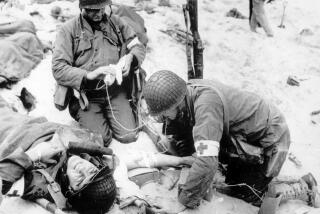Advances in treatment help more people survive severe injuries to the brain
In the 1946 issue of the Annals of Surgery, U.S. Army Maj. Ralph A. Munslow chronicled in exquisite detail the emergency care of 140 soldiers and civilians who suffered grievous head wounds â mainly from shell fragments â during the 5th Armyâs 1944 operation to seize and hold a beachhead in Anzio, Italy.
While liberally sprinkling antibiotic sulfa powder, and later penicillin, directly into his patientsâ gaping head wounds, Munslow meticulously collected all traces of foreign bodies and skull fragments, he reported. Where it was not possible to coax out debris with a magnet, Munslow would poke his finger into the soft tissue in a thorough effort to clean the patientâs brain.
It was an approach that prevailed â with refinements â through the Vietnam War and beyond, yielding only in recent years to new discoveries about the dynamics of the injured brain. Today, neurosurgeons are more likely to remove large chunks of intact skull than to vacuum up tiny shards of debris â to give an injured brain room to expand while also leaving it in peace to recover from a violent insult.
âA lot of what was done in the early treatment of Congresswoman [Gabrielle] Giffords are things that would not have been done 20 years ago â even 15 years ago,â says Dr. Jam Ghajar, president of the Brain Trauma Foundation and a neurosurgeon at New York-Presbyterian Hospital/Weill Cornell Medical Center.
Military surgeons such as Munslow have long been the nationâs principal repositories of wisdom on the emergency care of those with penetrating brain injuries. But as gun violence accelerated in the United States after the 1970s, civilian physicians like Ghajar developed expertise of their own. And both groups were influenced by what neuroscientists were learning about the brainâs response to injury.
The result is the widespread adoption of guidelines drafted by the Brain Trauma Foundation in 1995 for the treatment of severe brain injury. As a result, survival has improved among patients whoâve suffered a blunt or penetrating brain injury severe enough to have induced coma. In 1980, the overall death rate for such patients was 55%, Ghajar says; by 2010, it was just 20%.
The changes begin in the ambulance or helicopter that speeds to a trauma center. Emergency medical technicians have dialed down the pressure with which they pump oxygen into a victimâs lungs â a shift that, counterintuitively, improves blood flow to the stricken brain. They start the patient early on intravenous fluids â a lifesaving measure that first responders long avoided for fear it would promote brain swelling.
Once at the hospital, teams of specialists work to keep the bodyâs blood pressure from falling because that could rob brain tissue of the fuel and oxygen it needs more urgently than ever. At the same time, they act to keep pressure within the skull from rising. If a pressure monitor inserted in the brain shows that disturbed brain tissue is swelling, surgeons will act quickly: Cutting cleanly around shattered skull, they will create a large hole in the cranium to give the brain room to expand. The procedure, called decompressive craniectomy, prevents healthy tissue from being squeezed or crushed within the tight confines of the skull â a crisis that can kill brain cells not directly harmed by the bullet.
As for the fastidious cleaning performed by Munslow and his successors, that was laid to rest by Iranian physicians who operated in conditions not much more advanced than those in which Munslow worked. In 2003, they reported in the journal Surgical Neurology that the aggressive removal of shrapnel and debris does more harm than good in those who survive the most penetrating brain injuries. The group based its findings on its membersâ exhaustive experience treating soldiers during the eight-year war between Iran and Iraq.
âPatients get sicker when we operate on them to remove fragments,â says Duke University neurosurgeon Gerald Grant, who experienced this firsthand treating troops with traumatic brain injuries at Joint Base Balad in Iraq. âThey get edema [swelling]. Thereâs blood loss. They have clotting problems.â
Neurosurgeons now do a cursory cleanup of the areas where a projectile went in or came out, remove brain tissue that has been churned into pulp and excise any blood clots they can find. And the Munslow treatment? âWe just donât do it anymore,â Grant says.







